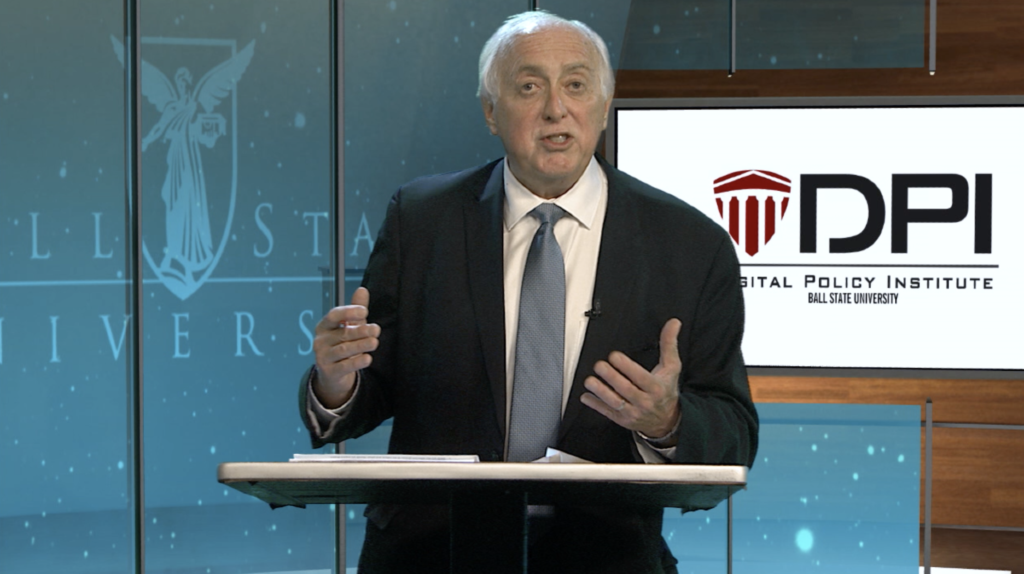For 5G, Panelists Favor Limiting Local Control over Rights-of-Way and Not Reinstating Net Neutrality Rules
WASHINGTON, July 6, 2019 — The successful growth of 5G networks will be best achieved through limiting municipalities’ control over wireless infrastructure and not reinstating rules that would require network neutrality, according to a Monday panel of the Digital Policy Institute, an organization af
Em McPhie

WASHINGTON, July 6, 2019 — The successful growth of 5G networks will be best achieved through limiting municipalities’ control over wireless infrastructure and not reinstating rules that would require network neutrality, according to a Monday panel of the Digital Policy Institute, an organization affiliated with Ball State University.
Although the government plays an important role, the buildout of 5G will be primarily led by the private sector, said Stephanie Hall, director of innovation policy at the National Association of Manufacturers.
“The private sector is standing by and they’re ready to make the investment in the infrastructure,” she said. “The role that the federal government needs to play is to remove barriers to the buildout of that infrastructure.”
Panelists praised the Federal Communications Commission’s controversial decision to futher limit municipalities’ role in regulating what small cell and 5G towers are placed within their rights-of-way through the September 2018 infrastructure order.
The government should also ensure that net neutrality rules are not reinstated, said Fred Campbell, former Chief of the Wireless Telecommunications Bureau at the FCC. Burdening investment with additional regulations on the technology would create a disincentive for companies pursuing 5G development.
Former Wireless Technology Association Director Peter Rysavy agreed, pointing out that net neutrality regulations doesn’t make sense in a 5G world. Urgent messages need to have a higher priority, and it’s possible to do this in way that is fair and doesn’t undermine other applications.
For example, an urgent signal going to an autonomous car about the presence of a pedestrian should be prioritized over a person streaming a YouTube video, especially since the video streaming wouldn’t even be affected by the deprioritization.
The continued development of technology will force policy debates—like the one over net neutrality—to move in more thoughtful and nuanced directions, said Campbell.
5G is “significantly different” from previous cellular technologies “because it vastly increases the scope of applications and use cases that cellular technology can address,” said Rysavy.
It also has the ability to operate in a far greater range of spectrum. While most cellular technology today only runs up to about 2.5 gigahertz, said Rysavy, 5G currently supports up to 50 gigahertz and there are ongoing efforts to potentially expand this figure to more than 100.
Higher bands have much greater bandwidth available and using wider radio channels will lead to multiple gigabit per second speeds. These factors mean that 5G will play a much greater role in the economy than previous cellular technologies, according to Rysavy.
The combination of high speed and low latency will unlock a variety of new use cases and transform the entire manufacturing ecosystem, Hall said. 5G development will affect device makers and network equipment manufacturers as well as revolutionizing other industries by catalyzing innovations like autonomous vehicles and smart agriculture.
5G could also play a significant part in closing the digital divide. Wireless connections are inherently much less expensive than running wire, cable, or fiber to remote rural locations, and with line-of-sight propagation and directional antennas, a signal could be run for several miles.
Harnessing mid-band frequencies for 5G deployment would provide enough bandwidth for high throughput connections with a low enough frequency to deploy cells that aren’t too dense, resulting in an “excellent solution for rural broadband,” said Rysavy.
However, there needs to be more conversation about how 5G will actually be deployed to rural areas, said Campbell.










Member discussion